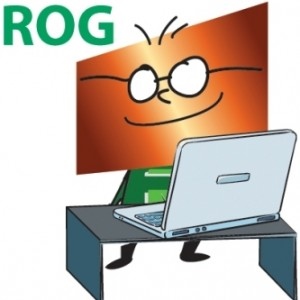
Published
by John Coonrod, Technical Marketing Manager
Advanced Electronics Solutions
This post authored by John Coonrod, Technical Marketing Manager, and team originally appeared on theROG Blog> hosted by Microwave Journal.
Woven glass is incorporated into printed-circuit-board (PCB) materials to provide structural strength. It aids the mechanical stability of a laminate, but what does it do to its electrical behavior? One of the classic concerns regarding woven glass reinforced laminate PCBs is that the “glass weave effect” can have negative impact on the electrical performance of high-speed or high-frequency circuits fabricated on these laminates. In this blog post, we examine some of the factors affecting the glass weave effect phenomenon.
Depending on the particular resin system of a woven-glass laminate, the dielectric constant (Dk) of the material can vary by location, in extremely small and periodic ways. These small areas with different Dk values can be due to the glass weave pattern, where the woven-glass fabric has areas of glass bundles and areas that are openings between the glass bundles (see the figure). The Dk of the glass bundles is typically about 6, while the Dk of the laminate in open areas between the bundles is much lower, typically around 3. The variation in Dk value has been a concern for circuit designers working with woven-glass laminates, since the impedance of high-speed / high-frequency transmission lines is highly dependent upon Dk.
As an example of how the glass weave effect can have an impact on a microstrip transmission-line circuit, consider a laminate with top and bottom copper layers (signal conductor and ground plane for microstrip) with a Dk of 3.0 in the z-axis (thickness) at 10 GHz. Dk variation in the circuit material typically will affect performance more at higher frequencies, such as millimeter-wave frequencies (30 GHz and above). At 77 GHz, for example, the one-quarter wavelength of signals propagating through the circuit is about 0.024 in., which would make the one-eighth wavelength about 0.012 in. In theory, when an electromagnetic (EM) wave encounters any kind of Dk change in its propagating medium that is larger than one-quarter wavelength of the frequency of interest, propagation will be disrupted and resonances can occur.
Practical experience has shown that even anomalies as small as one-eighth wavelength can cause wave propagation issues. Circuit laminates with openings in the glass or glass bundles that are one-eighth wavelength or larger at a frequency or frequencies of interest could suffer performance irregularities because of the distribution of glass bundles (and corresponding variations in Dk). Given the various styles of glass used to reinforce different circuit laminates, it is not unusual for several of these glass types to have window openings that are one-eighth wavelength or larger at 77 GHz (0.012 in.).
As multiple plies of woven glass are stacked to form a laminate, it is less likely for glass bundles and openings to align. As a result, it is less likely for discrete Dk variations due to the location of glass bundles and window openings. Therefore, the impact of the glass weave effect at millimeter-wave frequencies is decreased for woven-glass circuit materials using two or more layers of glass fabric.
Greater concern regarding the glass weave effect is for high-speed and high-frequency circuits using a laminate with a single layer of woven-glass fabric. Using a microstrip circuit as an example, fabricated on a laminate with one glass weave layer, one concern has to do with the randomness of the glass weave effect when using woven-glass circuit materials and trying to achieve repeatable performance in high-volume production. Variations due to the glass weave effect can result in circuit-to-circuit performance variations. The random location of the woven-glass pattern as it relates to the circuit pattern can result in microstrip impedance variations that cause shifts in the phase angles of propagating high-frequency waves, resulting in degradation of any phase-sensitive signal characteristics, such as phase-based modulation.
While a laminate using multiple layers of a woven-glass fabric may help mitigate the glass-weave effect for high-speed and high-frequency circuits, multiple coupled or differential conductors on a single-layer circuit can expose additional problems with the glass weave effect. The degradation in conductor phase characteristics noted earlier can also impact coupled circuits or differential lines. Because such circuits have well-defined relationships between or among the conductors, each conductor requires the same wave propagation medium. If each conductor in a coupled pair has a different medium, they will not couple as expected. In pairs of differential lines, the phase angles will vary if the Dk values of the wave propagation medium varies between the pairs of lines. The end result is a slowing of the propagation of one signal wave versus the other, resulting in skew. Particularly in high-speed digital circuits, skew caused by the glass weave effect can significantly degrade performance due to changes in signal timing.
Changes in Dk due to the glass-weave effect can be moderated by fabricating a laminate with a filled resin system rather than an unfilled resin system. The filler typically has a different Dk value than the resin or the glass, and it fills the open spaces between the glass. The use of a filler results in a material with less-drastic changes in Dk in the small isolated areas between the glass bundles, with an effective averaging of the Dk values with the combinations of glass fabric, resin, and filler.
Another method is the use of spread/flat glass fabric along with minimizing the relative glass content in the laminate with respect to the filler and resin. This combination provides the mechanical benefits of glass reinforcement while minimizing the Dk variation along the signal propagation path.
Of course, one way to overcome the glass weave effect altogether in a circuit laminate is to do without the woven glass. An example of such a material is RO3003™ laminate from Rogers Corp., with no woven glass fabric. It has become quite popular as a laminate solution for high-volume millimeter-wave circuits. RO3003 laminates are ceramic-filled PTFE composite materials with dielectric constant of 3.00. The dielectric constant is maintained within ± 0.04 across the circuit board and from lot-to-lot of circuit material. Such Dk consistency is vital for the small wavelengths of millimeter-wave circuits, but also for coupled lines as well as differential pairs in high-speed digital circuits. It is the type of Dk consistency that is difficult to achieve with woven-glass circuit materials, due to the glass weave effect.
Download the ROG Mobile app to access Rogers’ calculators, including the popular Microwave Impedance simulation tool, literature, technical papers, and the ability to order samples of the company’s high performance printed circuit board materials.
Ask an Engineer
Do you have a design or fabrication question? Rogers Corporation’s experts are available to help. Log in to the Rogers Technology Support Hub and “Ask an Engineer” today.
Tags:
ROG Blog, Wired Infrastructure
Published on May 26, 2017

